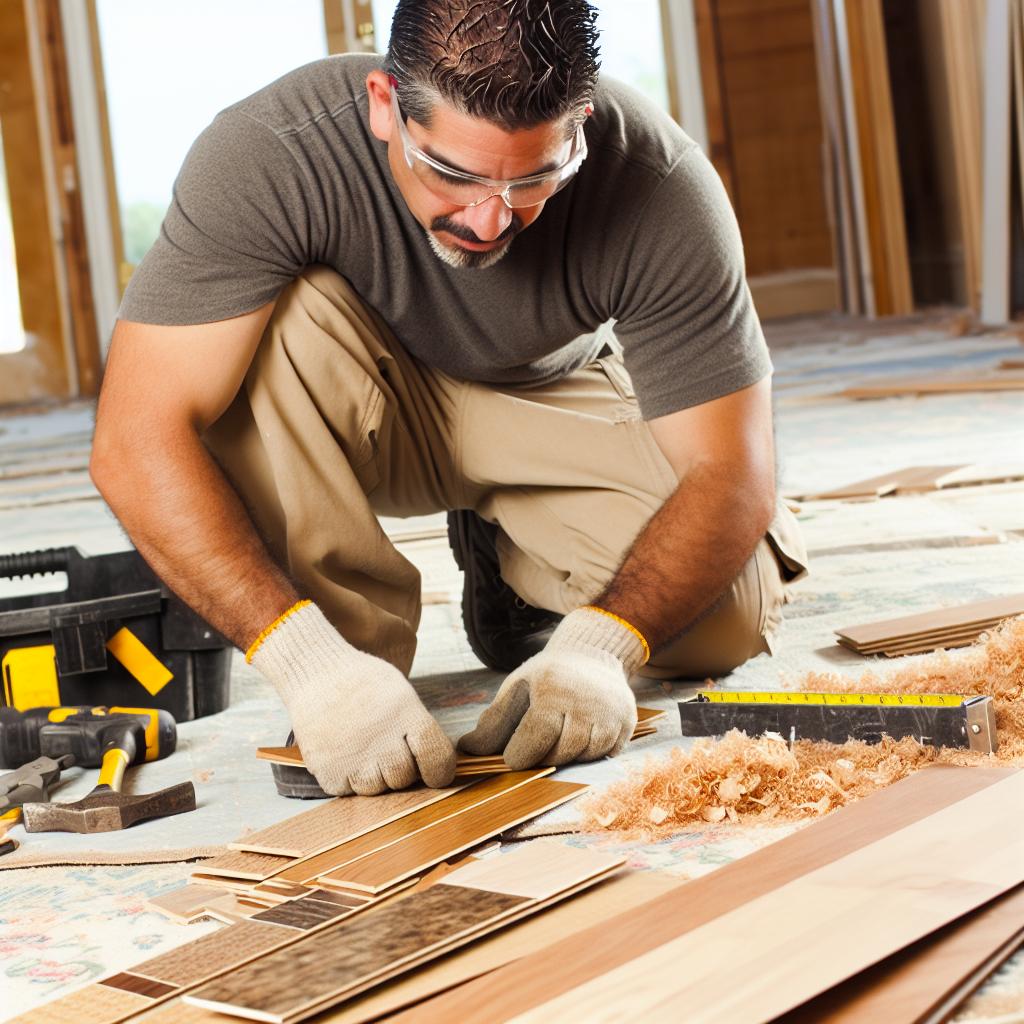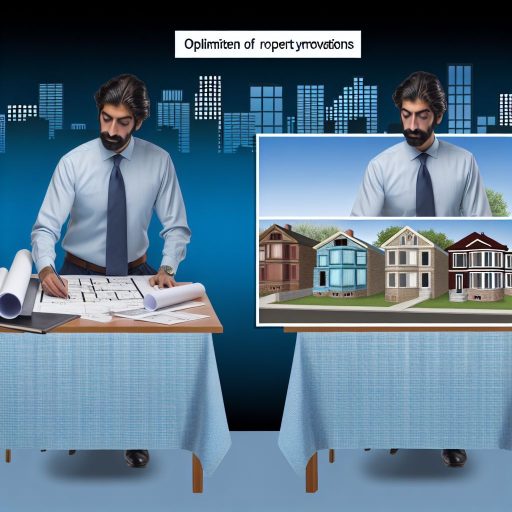Introduction to DIY Flooring Renovation for Real Estate Investors
Investing in real estate can be rewarding.
However, costs can quickly add up with renovations.
Focusing on DIY flooring projects can save money.
Moreover, updated flooring increases property value.
This article explores effective DIY flooring ideas.
Adding a personal touch may enhance buyer appeal.
First, let’s look at some benefits of DIY flooring renovations.
Benefits of DIY Flooring Renovation
One significant advantage is cost savings.
Purchasing materials and doing the work yourself saves labor costs.
Additionally, DIY renovations offer flexibility in design.
Creative choices can attract potential buyers.
Furthermore, hands-on work provides firsthand experience.
You gain valuable skills for future projects.
Popular Flooring Options for DIY Projects
Several flooring types are suitable for DIY renovations.
For example, laminate flooring is easy to install.
Transform Your Real Estate Decisions
Unlock personalized real estate insights crafted just for you. Get actionable advice designed to amplify your success.
Get Started- It requires minimal tools.
- Laminate mimics the look of hardwood.
- It is available in various designs.
Vinyl planks provide another excellent alternative.
- They are waterproof and durable.
- Installation often involves no glue or nails.
- Vinyl comes in various styles, including realistic wood designs.
Additionally, consider ceramic tiles for wet areas.
Tiles offer excellent water resistance and durability.
DIY Flooring Renovation Tips
Planning is crucial for a successful flooring project.
First, assess the space you want to renovate.
Measure accurately before purchasing materials.
Next, set a realistic budget for your renovation.
Research material costs and factor in additional supplies.
Additionally, prepare the area before beginning.
You may need to remove old flooring or prep the subfloor.
Lastly, follow the manufacturer’s instructions carefully.
This ensures that your installation will last.
Types of Flooring Options Suitable for DIY Projects
Vinyl Flooring
Vinyl flooring is an excellent choice for DIY enthusiasts.
It comes in a variety of styles and colors.
Showcase Your Real Estate Business
Publish your company profile on our blog for just $200. Gain instant exposure and connect with a dedicated audience of real estate professionals and enthusiasts.
Publish Your ProfileMoreover, it is straightforward to install.
Many vinyl options feature a peel-and-stick design.
This makes it easy for anyone to tackle a flooring project.
Laminate Flooring
Laminate flooring provides a wood-like appearance without the cost.
It is durable and resistant to scratches and stains.
Installation is usually a simple click-lock process.
Thus, DIYers can complete it without professional help.
This option is great for high-traffic areas.
Engineered Hardwood
Engineered hardwood offers a real wood look at an affordable price.
This flooring is more stable than solid hardwood.
It can handle fluctuations in temperature and humidity well.
Installation can be done as a floating floor.
Therefore, homeowners find it easy to manage.
Cork Flooring
Cork flooring is another unique option for DIYers.
It is eco-friendly and provides excellent insulation.
This material is sound-absorbent, making spaces quieter.
Installing cork is manageable with glue-down or click-lock methods.
Additionally, it is comfortable underfoot.
Carpet Tiles
Carpet tiles offer a versatile flooring solution.
They come in various colors and patterns, appealing to many styles.
The tiles are easy to replace if damaged.
Installation is typically a matter of laying out and adhering.
It allows room for creativity in designing your space.
Cost-Benefit Analysis of DIY Flooring Renovation
Understanding the Costs
DIY flooring renovations may seem cost-effective at first glance.
However, hidden expenses can quickly add up.
You need to account for materials, tools, and labor.
For instance, purchasing high-quality materials often requires a larger upfront investment.
Additionally, rental costs for tools can contribute to the overall expense.
Unexpected repairs or mistakes can further inflate costs.
In summary, thorough budgeting is essential for successful DIY projects.
Showcase Your Real Estate Business
Publish your company profile on our blog for just $200. Gain instant exposure and connect with a dedicated audience of real estate professionals and enthusiasts.
Publish Your ProfileEvaluating the Benefits
One major benefit of DIY flooring is potential cost savings on labor.
You gain valuable skills and knowledge by handling the renovations yourself.
Such projects often yield personal satisfaction upon completion.
A well-executed DIY floor can enhance your property’s value significantly.
Moreover, you can choose materials and styles that appeal to your target market.
These benefits make DIY flooring a rewarding investment for real estate investors.
Long-Term Return on Investment
Understanding the long-term return on your investment is crucial.
A newly renovated floor can attract higher rental prices or sale values.
Quality flooring helps appeal to potential renters or buyers.
Furthermore, aesthetically pleasing interiors can lead to quicker sales.
Consider the increased demand in competitive real estate markets.
Ultimately, investing in quality flooring today pays off in the long run.
Time Considerations
Time is another factor in your DIY flooring project.
Managing personal and professional schedules can be challenging.
DIY tasks often take longer than anticipated, delaying project completion.
Understanding your timeline helps in making informed decisions.
Consider the urgency of your renovation in relation to the housing market.
Thus, evaluating your available time is essential for planning effectively.
Weighing Risks and Rewards
Finally, consider the risks associated with DIY renovations.
Mistakes can lead to costly repairs or reduce the appeal of your property.
It’s crucial to evaluate your skill level before committing to a project.
On the other hand, successful DIY flooring can increase confidence.
Engaging in future projects becomes easier with gained experience.
In summary, balance the rewards against potential risks wisely.
Uncover the Details: The Role Of Sustainability In Modern Property Development Practices
Step-by-Step Guide to Installing Laminate Flooring
Gather Your Tools and Materials
Begin by gathering all necessary tools for the job.
Ensure you have the following items:
- Laminate flooring planks
- Underlayment
- Measuring tape
- Utility knife
- Miter saw
- Flooring installation kit
- Rubber mallet
- Safety goggles
Prepare the Installation Area
Clear the installation area of all furniture and debris.
Ensure the subfloor is clean, dry, and level.
If needed, make repairs to any uneven surfaces.
Showcase Your Real Estate Business
Publish your company profile on our blog for just $200. Gain instant exposure and connect with a dedicated audience of real estate professionals and enthusiasts.
Publish Your ProfileAcclimate the laminate planks for at least 48 hours in the room.
Install the Underlayment
Unroll the underlayment over the entire floor area.
Ensure the seams of the underlayment are butt-jointed.
Tape the seams together to prevent moisture accumulation.
Lay the First Row of Planks
Start laying the laminate planks along the longest wall.
Place the first plank with the groove facing the wall.
Leave a gap of about 1/4 inch for expansion.
Continue laying planks in the same direction, connecting their tongues and grooves.
Cut Planks to Fit
Measure the space at the end of the row.
Use a utility knife or miter saw to cut the final plank as needed.
Ensure each cut plank fits snugly while maintaining the expansion gap.
Install Subsequent Rows
For the second row, start with a plank that is at least 12 inches shorter than the first plank in the first row.
Stagger joints between rows for stability.
Continue connecting the planks using a rubber mallet for snug fits.
Finishing Touches
Install baseboards or quarter-round moldings to cover expansion gaps.
Clean the floor thoroughly to remove any dust and debris.
Finally, replace furniture once the installation is complete.
See Related Content: The Role Of Market Research In Real Estate Development Success
How to Choose the Right Flooring Material for Your Property
Assessing Your Property’s Needs
Start by evaluating the specific needs of your property.
Consider the type of space you are renovating.
Identifying high-traffic areas is crucial for durability.
Additionally, think about the overall aesthetic you want to achieve.
Understanding Different Flooring Options
Research various flooring materials available on the market.
Hardwood is a classic choice, offering warmth and elegance.
Laminate provides a budget-friendly and versatile alternative.
Tile is known for its durability and ease of maintenance.
Carpet adds comfort but requires more upkeep relative to other options.
Evaluating Cost vs. Value
Assess the costs associated with each type of flooring.
Consider installation expenses along with the material cost.
Higher-priced options can sometimes provide better long-term value.
Showcase Your Real Estate Business
Publish your company profile on our blog for just $200. Gain instant exposure and connect with a dedicated audience of real estate professionals and enthusiasts.
Publish Your ProfileThink about maintenance costs to obtain a full financial picture.
Climate and Environmental Factors
Analyze how climate affects your flooring choice.
Certain materials perform better in varying weather conditions.
For example, tiles can be ideal for humid areas.
In contrast, hardwood may expand or contract based on moisture levels.
Choosing Eco-Friendly Options
Consider sustainable flooring options as an alternative.
Bamboo and cork are both renewable and eco-friendly.
Reclaimed wood offers a unique look while being environmentally responsible.
Additionally, exploring low-VOC products will benefit indoor air quality.
Consulting Professionals
Don’t hesitate to consult flooring experts for advice.
Professionals can offer insights based on your specific situation.
They can help you navigate through available options.
Ultimately, their expertise can lead to a more informed decision.
Learn More: How To Create A Budget For Property Development And Stick To It
Essential Tools and Equipment for DIY Flooring Installation
Basic Tools
Gathering the right tools is vital for a successful flooring project.
Start with standard tools like a tape measure and a utility knife.
A square helps ensure straight cuts and proper angles.
Invest in a sturdy hammer for nailing down materials.
Your toolbox should also include a pry bar for removing old flooring.
Using a vacuum or broom keeps your workspace clean and safe.
Specialized Flooring Tools
Flooring-specific tools make installation easier and more efficient.
A rubber mallet is useful for tapping planks into place without damage.
Consider a flooring nailer if you are working with hardwood.
A tile cutter is essential for installing ceramic or stone tiles.
Additionally, a level ensures your finished floor is even.
You might also need a saw, like a jigsaw or miter saw.
Protective Gear
Safety should not be overlooked when installing flooring.
Wear safety goggles to protect your eyes from debris.
Hearing protection is important, especially when using power tools.
A dust mask helps to filter out harmful particles in the air.
Showcase Your Real Estate Business
Publish your company profile on our blog for just $200. Gain instant exposure and connect with a dedicated audience of real estate professionals and enthusiasts.
Publish Your ProfileSturdy gloves protect your hands from cuts and splinters.
Non-slip shoes provide traction on slippery surfaces.
Installation Supplies
Aside from tools, gather necessary installation materials.
Underlayment is crucial for soundproofing and moisture protection.
Adhesives or nails may be required depending on your flooring type.
Ensure you have enough flooring material to cover your area.
Be sure to have transition strips for seamless flooring changes.
Rounding up your supplies helps avoid last-minute trips to the store.
Uncover the Details: DIY Renovation Mistakes Real Estate Owners Should Avoid

Common Mistakes to Avoid in DIY Flooring Projects
Insufficient Planning
Many investors jump into flooring projects without a solid plan.
This often leads to costly mistakes and wasted materials.
Taking time to plan will save you money in the long run.
Identify your specific goals and budget before starting.
Poor Measurement
Accurate measurements are crucial in flooring renovations.
Many DIYers underestimate how much material they need.
Always double-check your measurements before making purchases.
This helps prevent overbuying or underbuying materials.
Neglecting Subfloor Preparation
Sometimes, DIYers forget to assess the subfloor condition.
A damaged subfloor can lead to problems later on.
Ensure the subfloor is clean, dry, and level before installing new flooring.
This will promote long-lasting results and prevent issues.
Ignoring Acclimation
Not allowing flooring materials to acclimate is a common mistake.
Wood and laminate flooring require time to adjust to room conditions.
Failing to do this can result in warping or buckling later.
Follow the manufacturer’s guidelines regarding acclimation.
Choosing the Wrong Material
Selecting inappropriate flooring materials can create setbacks.
Consider the room’s purpose, foot traffic, and moisture levels.
Some materials are better suited for high-traffic areas.
Research options to find the best fit for your needs.
Overlooking Local Building Codes
Every area has specific building codes regarding flooring installation.
Showcase Your Real Estate Business
Publish your company profile on our blog for just $200. Gain instant exposure and connect with a dedicated audience of real estate professionals and enthusiasts.
Publish Your ProfileIgnoring these regulations can lead to fines or having to redo work.
Always check with local authorities to ensure compliance.
This ensures your project meets legal standards and safety measures.
Forgetting About Maintenance
It’s easy to overlook the long-term maintenance of flooring.
Some materials require regular upkeep to maintain their appearance.
Consider how much effort you’re willing to invest in maintenance.
Choose flooring that aligns with your lifestyle and cleaning habits.
Inadequate Lighting During Installation
Good lighting is essential when working on flooring projects.
Poor visibility can result in mistakes during cutting and placement.
Ensure your workspace is well-lit to minimize errors.
This will help you maintain accuracy throughout the project.
Tips for Maintaining and Caring for New Flooring
Routine Cleaning
Regular cleaning keeps your flooring looking great.
Use a soft broom or vacuum to remove dirt.
Avoid harsh chemicals that may damage the surface.
For spills, clean up immediately to prevent stains.
Use a damp cloth or mop for deeper cleaning.
Protecting Against Scratches
Furniture pads prevent scratches on your new flooring.
Consider using area rugs in high-traffic zones.
Regularly rotate rugs to ensure even wear.
Keep pet claws trimmed to minimize damage.
Humidity and Temperature Control
Maintain consistent humidity levels in your home.
Excessive moisture can warp flooring materials.
Use dehumidifiers in damp areas to reduce humidity.
Install a humidistat to monitor indoor conditions.
Periodic Maintenance
Schedule periodic professional cleaning for longevity.
Inspect flooring regularly for signs of wear.
Address small repairs before they become larger issues.
Consider resealing floors as needed for protection.
Adapting to Seasonal Changes
Adjust floor care practices with seasonal changes.
In winter, use mats at entrances to trap snow and dirt.
Showcase Your Real Estate Business
Publish your company profile on our blog for just $200. Gain instant exposure and connect with a dedicated audience of real estate professionals and enthusiasts.
Publish Your ProfileIn summer, be cautious with humidity from open windows.
How to Increase Property Value Through Flooring Renovation
Understanding the Importance of Flooring
Flooring is a key element in home aesthetics.
It significantly impacts property value and buyer perception.
Quality flooring can enhance the overall look of a space.
Investors should prioritize flooring during renovations.
Choosing the Right Flooring Material
Different materials yield distinct advantages and drawbacks.
Hardwood flooring appeals to many homebuyers.
Tile is resilient and perfect for high-moisture areas.
Vinyl flooring offers affordability with style options.
Laminate provides a budget-friendly alternative to hardwood.
DIY vs. Professional Installation
Consider your skills when deciding on installation methods.
DIY projects can save money on labor costs.
Ensure you have adequate tools and experience before starting.
Professional installation guarantees quality and durability.
Be prepared to invest additional funds for expert help.
Color and Design Trends
Current color trends can influence buyer interest.
Neutral shades enhance versatility and appeal.
Consider patterned flooring for added creativity.
Stay updated with trends through home design blogs.
Choose designs that complement the property style.
Maintaining a Budget
Set a clear budget before beginning any renovations.
Include costs for materials, tools, and potential labor.
Consider financing options if necessary.
Track expenses closely to avoid budget overruns.
Investing wisely can yield high property returns.
Final Touches and Presentation
The presentation can make a significant difference.
Clean thoroughly before showings to highlight new flooring.
Arranging furniture effectively can enhance visual appeal.
Good lighting makes flooring types stand out beautifully.
These touches attract potential buyers and boost interest.
Showcase Your Real Estate Business
Publish your company profile on our blog for just $200. Gain instant exposure and connect with a dedicated audience of real estate professionals and enthusiasts.
Publish Your ProfileAdditional Resources
Lessons learned buying a co-op undergoing a major renovation




